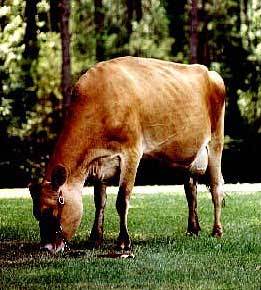 Jersey
Jersey
The Jersey breed originated on the
Island of Jersey, a small British island in the English Channel off the coast
of France. The Jersey is one of the oldest dairy breeds, having been reported
by authorities as being purebred for nearly six centuries.
Jersey bulls, while small as
compared to the other dairy breeds, are extremely masculine. They are quite
muscular about their crests and shoulders and are considerably less refined
throughout than are the females. The same general qualities of straight lines and
diary conformation as are found in the cows are desired in bulls. They usually
range in weight from 1200 to 1800 pounds.
Friesian
 The exact origins of the breed are difficult to determine
but it is known that in the 18th century, herds of small black-and-white cattle
were brought into northern Holland and Friesland from northern Jutland to
replace animals that had fallen victim to disease and flooding. These animals
were crossed with the existing Dutch cattle and formed the basis of the
Friesian.
The exact origins of the breed are difficult to determine
but it is known that in the 18th century, herds of small black-and-white cattle
were brought into northern Holland and Friesland from northern Jutland to
replace animals that had fallen victim to disease and flooding. These animals
were crossed with the existing Dutch cattle and formed the basis of the
Friesian.
Before the establishment of the Netherlands herdbook in
1873 and the Friesland herdbook in 1879, both black-pied and red-pied animals
were maintained separately. The preference for black-pied cattle, particularly
in the United States, led to the further segregation of red-pied animals and presently
this colour variation only exists in small number in the Netherlands.

Australian Milking Zebu
In an effort to overcome the problems of traditional dairy
breeds performing at reduced levels under hot, humid and tick-infested conditions,
the Commonwealth Scientific & Industrial Research Organization developed the Australian Milking Zebu (AMZ). This began in the mid-1950’s with
the introduction of Pakistani Sahiwal and Red Sindhi dairy cattle, which were
mated initially to high-producing Jersey cattle. Later, some infusion of
Illawarra, Guernsey and Holstein-Friesian bloodlines occurred.

Khillari
There is every reason to believe that the Khillari breed,
with its several varieties, owes its origin to the Hillikar breed of cattle
from Mysore State. Unlike some of the other breeds of cattle in India, it does
not take its name from a geographical area. Khillar means a herd of cattle,
while Khillari means belonging to Khillar; hence the herdsman is known as
Khillari; in the Satpura range of hills, he is known as Thillari. There is a
special tribe of professional cattle breeders in this region known as
Thillaris.
No comments:
Post a Comment